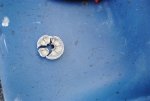scrambledegg
Member
**sorry, applies to mainsail, not headsail **
I've been having trouble hoisting my mainsail (~25 m sq) all the way to the top without using a winch, so I thought I would reduce friction by swapping the deck mounted plain-bearing 50mm turning block for a ball-bearing one of 60mm. It turns the halyard through 90 degrees.
I see now though that the ball-bearing blocks have lower safe working load that the plain-bearing ones. The one I bought says 300kg on the packet (but 500kg in the spec on the website, confusingly).
I mainly cruise the boat but I'm hoping that the racers on here might know what are normal luff tensions for mainsails, related to wind strengths.
Thanks
I've been having trouble hoisting my mainsail (~25 m sq) all the way to the top without using a winch, so I thought I would reduce friction by swapping the deck mounted plain-bearing 50mm turning block for a ball-bearing one of 60mm. It turns the halyard through 90 degrees.
I see now though that the ball-bearing blocks have lower safe working load that the plain-bearing ones. The one I bought says 300kg on the packet (but 500kg in the spec on the website, confusingly).
I mainly cruise the boat but I'm hoping that the racers on here might know what are normal luff tensions for mainsails, related to wind strengths.
Thanks

